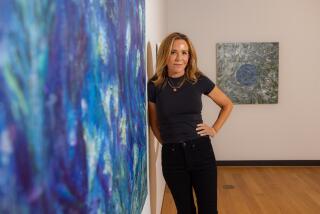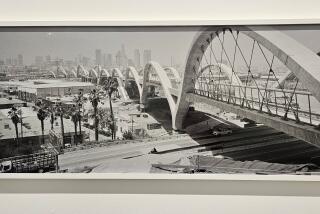One From the Art : Marilyn Rhode’s Portraits of Convalescent Home Patients Are Working a Quiet Miracle
- Share via
When Marilyn Rhode’s mother-in-law had a stroke, Marilyn sank too. It seemed a dirty trick, this agonizing fall into helplessness of a proud Scottish woman, proper in a way that you hardly see anymore. Nearly a year ago, Evelyn Rhode almost died.
At the time, Marilyn, who teaches elementary art education at Cal State Fullerton, was already way too busy as it was. Her daughter was about to graduate from high school; Marilyn was buzzing about, forever checking things off a master list. She supposed that this was what you did with life to be called a success. And, in that sense, Marilyn was. People said so. A career woman, a mother, a wife, she was a sloganeer’s dream.
Yet now her mother-in-law, 91, needed her care. Marilyn scheduled her in, for large blocks of time. And she became another demand, a moral obligation, a weight.
Until Marilyn took out her sketchbook and began to draw.
“When I first starting coming in here, I couldn’t even look at people for six months,” Marilyn says. “In a place like this, you hear, see, smell things that you aren’t accustomed to. I felt like I was under this dark cloud. It was literally suffocating me.”
We are at the Gordon Lane Convalescent Hospital in Fullerton now. Evelyn has since moved to another nursing home, where Marilyn tries to visit every day. But Marilyn, who is 47, returns here often, at least once a week. The obligation has vanished, as has the grief. Joy has taken their place.
It was Marilyn’s art that ushered this quiet miracle in. Then Marilyn just walked through the door and decided to stay and chat. Marilyn says this, rather than her art, is the important part.
She has found friendship, the kind with roots like tree trunks, in a place where too many people would not deign to look.
“I give these people the crumbs of my time and they just serve me a banquet of encouragement in return,” Marilyn says. “People just respond to me. When I leave here, it’s like I’m in a different world. Nothing I have done professionally measures up to this.”
For more than a year, Marilyn has been drawing the portraits of the patients she meets here and at two other nursing homes, and as she does, she talks with them about their lives, their fears and their hopes. Always there is touch, a pat on the shoulder, a hand held, a hug, a kiss.
Other times, words stay put, or the tears flow. The intimacy still soothes. It feels like something good.
Marilyn always gives her models copies of her work; no money is ever involved. Of the hundreds of portraits she has done, in pencil, charcoal, pastel and watercolors, none is for sale.
“I’m afraid if I took money for them, something might change,” she says. “My goal is to show these people as meaningful and significant.”
This was realized long ago.
“She just makes people feel good,” says patient model Ed Bergeron, 69. “I imagine it’s her heart.”
“I love her,” says another, Helen Gruthusen, 87.
“I always go away wondering why you picked me!” asks model Edna Harris, 90, as Marilyn recreates her image with her hands. “With all the good-looking people around here, why me?”
“Because you’re special,” Marilyn says.
“Well, honey, I feel great,” Edna comes back. “Thank you very much.”
Yet, really, it is clear by watching Marilyn do what she does that the pleasure is her own. This is not work, nor anything scheduled in a structured sense. It seems a quest, like a treasure hunt for the humanity in all of these patients, the connection that confirms us as human beings.
“I hate to admit this,” Marilyn says, at once embarrassed and thrilled that I have come to record what she does. “But I was a perfectionist. This has forced me to slow down and forced me to enjoy every moment as it is. I don’t always need to be reading and preparing for a goal.
“This has taught me to listen, how to be more patient, how to accept the hand that life’s given me if I can’t change something. And this has helped me deal with my own mortality as well.”
Since Marilyn began drawing the nursing home patients--including her favorite, Evelyn--she has begun taking courses in gerontology, although she is not sure, exactly, why. The experience of meeting these people has changed her life. She is eager to see where it might lead.
“What I’ve realized is that my gift is more in the doing of art,” Marilyn says. “What I am, really, is an artist. . . . I’m hoping my pictures can help motivate and soften people’s hearts, to reach out to these people, rather than to fear them.”
One day, she says, she’d like to put together a publication, which would include her portraits, that could help people learn how to care for those in need, the elderly and perhaps, handicapped children too.
“All of this has given me an incredible passion for life,” Marilyn says. “And I have to say that God has been in this from the start. I feel like he’s just peeled the scales off my eyes.”
Marilyn Rhode has been doing something, quietly, that works. Not everyone can draw, she says, but everybody can show somebody else that they care.
“Marilyn is a doll,” says Helen.
“Well, with what you had to work with, you did a good job,” Edna says when seeing Marilyn’s latest portrait of her for the first time. Then she smiles and rolls it into a laugh.
Dianne Klein’s column appears Tuesday, Thursday and Sunday. Readers may reach Klein by writing to her at The Times Orange County Edition, 1375 Sunflower Ave., Costa Mesa, Calif. 92626, or calling (714) 966-7406.
More to Read
The biggest entertainment stories
Get our big stories about Hollywood, film, television, music, arts, culture and more right in your inbox as soon as they publish.
You may occasionally receive promotional content from the Los Angeles Times.










